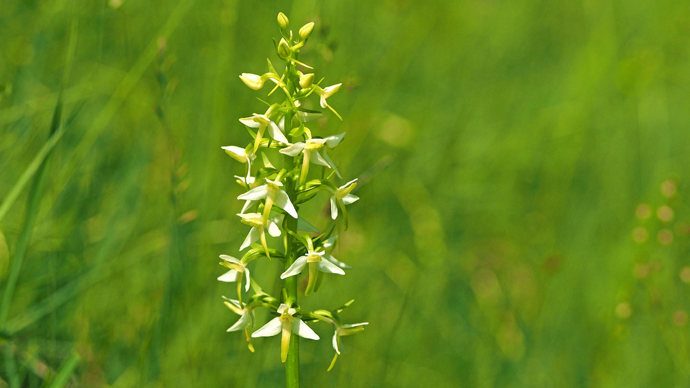Common name: greater butterfly-orchid
Scientific name: Platanthera chlorantha
Family: Orchidaceae (orchids)
Origin: native
Flowering season: May to July
Habitat: broadleaf woodland, fields, along hedgerows
Tall and glowing, the greater butterfly-orchid sways over unimproved grasslands and open woods. Though not so sweet-smelling as its lesser relative, keep a nose out for it in the early evening when it is at its most pungent.
Common name: greater butterfly-orchid
Scientific name: Platanthera chlorantha
Family: Orchidaceae (orchids)
Origin: native
Flowering season: May to July
Habitat: broadleaf woodland, fields, along hedgerows
A tall and upright orchid in meadows and open woodland, the greater butterfly-orchid is fond of chalky soils.
Leaves: are bright green. Only two large leaves grow from the base of the plant with a few smaller ones higher up the stem.
Flowers: can number from 10 to 40 on a flower spike. They are white and green in colour.
Not to be confused with: the lesser butterfly-orchid (Platanthera bifolia) which is very similar in appearance, but prefers open and heath habitats and has a strong vanilla scent in the early evening.

Credit: Steve Holroyd / Alamy Stock Photo
The greater butterfly-orchid grows throughout Europe, but is scarce in southern regions. It’s found throughout the UK, most frequently in the south, but is uncommon. Spot the plants in unimproved grassland and open broadleaved woodland.
These plants are important sources of nectar for invertebrates.
They emit a strong scent at night intended to attract the moths that pollinate them.
There are few uses for the greater butterfly-orchid, but the lesser butterfly-orchid has been used in traditional medicine for gastro-intestinal soothing.
This species has suffered declines in the UK. In the lowlands it has been lost through drainage, woodland disturbance and agricultural intensification, while upland populations have been lost to intensive grazing. The plant is now classified as Near Threatened and is uncommon in the UK.
Keep exploring